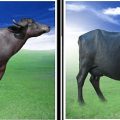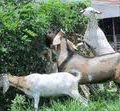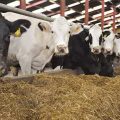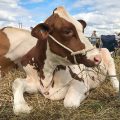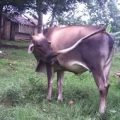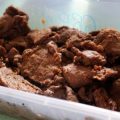The Department of Agriculture (DA) is importing Braunvieh cattle semen from Switzerland which will produce “dual purpose” calves both for beef and dairy.
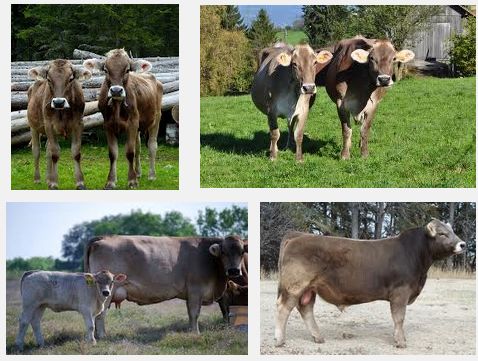
The importation of semen will enable crossbreeding of the Braunvieh Swiss breed with locally available cattle breeds. It will bring down the cost of producing offspring of superior breeds.
It can replace the more expensive system of importing cattle for breeding or for dairy use. Importation of dairy cattle can cost P150,000 to P180,000 per animal.
Direct beneficiaries of the program are cattle raisers of the Camiling Cattle Association (CCA) of Camiling, Tarlac. It has around 50 cattle-raising members.
“We have the capability for breeding this Swiss animals with the cows and other resources we have,” said CCA President Rene G. Abad.
“We never had a vision to develop cattle both for beef and for dairy production. We followed a model that is not appropriate to our situation.”
The concept that the country adopted separated breed for dairy production and the animal for beef production. But Braunvieh is a breed for this dual purpose—dairy and beef production.
The project “Commercialization of Braunvieh Crossbred Cattle for Dairy and Beef (Dual Purpose) Production” by the Camiling Cattlemen Association (CCA) is being funded by the DA’s Bureau of Agricultural Research (BAR) with almost P1 million.
The CCA members will provide their cows for breeding, collect the data, manage the project, and grow the resulting crossbred F1 calves.
The project is importing 1,320 straws of elite Braunvieh bull semen from Switzerland coming from proven progeny tested bulls.
“We’re able to get the semen straw at an affordable landed price of only P250 per straw,” said Abad.
The government should invest in a breeding program for cattle which would uplift the lives of smallholder farmers, according to BAR Director Nicomedes P. Eleazar.
“There are stakeholders in the cattle raising business who are small farmers. It is our mandate to look for possibilities in enhancing their competitiveness through technology,” said Eleazar.
Filipino cattle raisers who own just one or two animals represent the big bulk of the country’s live cattle inventory, according to Abad.
“Small cattle raisers account for 92 percent of our cattle population. Big ranchers represent less than eight percent. But it’s unfortunate that in the past government has not adequately consulted with the needs of the smallhold sector. It’s good we’re getting this attention and help from BAR under Director Eleazar,” he said.
The commercialization of Braunvieh is tapping the expertise of the Philippine Carabao Center in artificial insemination (AI).
PCC technician fee is presently at P500 per successful AI. PCC is also expected to provide the liquid nitrogen which ensures preservation of semen straw for AI.
Importation
This BAR-funded program may perhaps in the long term enable substitution even a small amount of what the country imports. The Philippines imported $105 million (2) (P4.2 billion) worth of beef and beef products as of 2005 based on a United States agriculture/” title=”View all articles about Department of Agriculture here”>Department of Agriculture report. This was mostly carabao meat (carabeef) from Brazil and India.
For dairy and milk, the Philippines imported as of 2006 $457.3 million worth of products. Imports come from New Zealand, Australia, and the United States.
For dairy cattle, the National Dairy Authority (NDA) is also importing 700 dairy animals from New Zealand up to February 2014. This is for a total of 2,100 heads with a total cost of P294 million at an estimated P140,000 per head.
Available cattle
The Philippines has locally available cattle breeds that can be crossed with Braunvieh. Some of these are native breeds, while some animals are crossbreds of the native and Brahman and other Zebu (generic for cattle that have hump) breeds of Indian origin.
Zebus originated from India and Africa and are suitable for tropical climate as the Philippines.
The country also once received the French white Charolais cattle as a gift from France. Charolaise is used solely for beef, and the cow is not used for producing dairy. Charolais grows at a fast 1.7 kilos per day.
“The French donated Charolais bulls to us in the 1960s that was used for crossbreeding, but it’s unfortunate we were not able to maintain and develop it,” he said.
Crossbreds with Braunvieh inherit superior traits such as fast growth, good beef quality, and higher milk production. This is perhaps eight liters or more per day instead of just two liters or less from the non-crossbred. For beef use, fattening calves can be slaughtered at an earlier two years of age with adequate feeding.
Cost Effective
It will be cost-effective for the Philippines to conduct its own breeding program considering some factors. The country with its tropical climate with high rainfall level and long sunlit days has abundant source of feed and forage.
Large grazing land may no longer be much available, but natural feed like grasses and those from ipil-ipil trees and other forage trees are easy to grow.
New jobs in rural areas can be created for grass and forage collectors. There also existing feed concentrates from agricultural by-products that have been proven to increase animal growth and achieve desired objective such as good milk production.
Coordination
Given its mission for smallhold cattle raiser, other government agencies have come in to aid in other aspects of breeding. For one, Bureau of Animal Industry (BAI) is already engaged in genomics program for identifying and breeding good traits in native animals, particularly swine.
“We will not be inseminating native cows to conserve the already low number of the Philippine cattle,” assured Abad.
BAI is supporting the project by maintaining the viability of the Braunvieh cattle semen at its National Artificial Breeding Center until it is used in the AI of the cows.
The CCA is also coordinating with the Tarlac College of Agriculture (TCA) in the analysis of the data collected. This data can be used by TCA students for their theses.
It is likewise coordinating with the local government units of Tarlac province and municipality of Camiling that commit to working on AI activities.
The BAR-CCA project has a capability-building component as the farmers are continuously trained on cattle raising specially in health, feeding, housing, and milking, among others. The project is experimenting on the use of ICT in its training activities and has collected a large amount of materials that can be used by other farmers.
The National Dairy Authority is assisting the project in the area of training for dairy production via seminars. Abad is hoping that the NDA will become a buyer later of their Braunvieh crossbred cows.
Braunvieh cattle are known for their good beef quality and higher milking quality. The male crossbred becomes ideal for fattening, and the female crossbred, for milking.
CCA expects a 30 percent efficiency in AI. Its expects the generation of around 400 calves from its semen straw import volume.
Needed policy
Crossbreeding of imported dual purpose breeds and local animals to produce more productive cattle for beef and dairy production should be the major program of government for cattle, according to Abad.
The DA’s Livestock Development Council could initiate the policy changes necessary to implement this, together with greater participation of the smallhold sector.
“Smallhold raisers nationwide can do massive crossbreeding with government assistance to produce more productive cattle to reduce our 99 percent dairy and 28 percent beef importation rates” said Abad.
This will result in job creation and increased income among smallhold farmers in the rural areas, and have multiplier effect on the whole economy.
“We don’t crossbreed, we’re just importing beef, milk and breeding animals. We can complement the old US model where there is a distinction between the dairy and the beef industry, with the dual purpose European and Latin American model.” Abad added.
Average rate of fattening of purebred Braunvieh is 1.3 kilos per day while the local cattle grows at only 0.3 kilos per day. If there is crossbreeding (the foreign at 1.3 kilos plus the 0.3 local), the resulting cattle can have higher average growth at 0.8 kilos or more per day with adequate feeding.
Earnings
Farmers who can care for three cows used to produce dual purpose calves can earn an annual gross income of P150,000 to P180,000. This is at a slaughter weight of 500 to 600 kilos per animal at an average price of P120 per kilo.
Cost mainly involves feeding.
“The person caring for the three cows has the time for other agricultural activities. Feedstuff like grass and forage that is readily available and suited only for ruminants like cattle are free,” said Abad.
CCA is looking forward to applying for a grant with the Agricultural Competitiveness Enhancement Fund or ACEF to expand its breeding work to benefit other smallhold farmers. CCA expects a 30 percent efficiency in AI. Its expects generation of around 400 calves from its semen straw import volume.
The BAR-CCA project also has a capability building part as farmers have to be continuously trained on cattle raising.
Needed policy
Crossbreeding of imported breeds and local animals should be the major program of government for beef and dairy, according to Abad. The DA’s Livestock Development Council should initiate this work.
“How do you expect small raisers to do the crossbreeding themselves?” said Abad. “We don’t crossbreed, we’re importing beef and milk. We still follow the old US model where there is a distinction between the dairy breed and the beef breed. The dairy breed is Hosltein and the beef, Brahman.”
Average speed of fattening of Braunvieh is 1.3 kilos per day. The local cattle grows at only 0.3 kilos per day. If there is crossbreeding (the foreign at 1.3 kilos plus the 0.3 local), the average growth will be higher at 0.8 kilos per day.
Earnings
Farmers who can tend three beef cattle can earn a gross income of P150,000 to P180,000. This is at a slaughter weight of 500 to 600 kilos per animal at an average price of P120 per kilo. Average retail price of beef in 2012 was P229.41 per kilo, according to the Bureau of Agricultural Statistics (BAS).
Cost mainly involves feeding.
“The person caring for the animals doesn’t have to be fully employed. Feed is only the natural feed around that are for ruminants like cattle,” said Abad.
CCA is also looking at applying for a loan with the Agricultural Competitiveness Enhancement Fund or ACEF for its breeding work.
Production
As of January 2013, the Philippines had a total cattle inventory of 2.497 million heads of cattle, according to the BAS.
Of this, 2.32 million heads or 93 percent comes from backyard farms and 174,547 (seven percent) comes from commercial farms.
The country’s cattle holding provinces are Ilocos Region, 292,545 heads; Central Visayas (Cebu, Bohol, Negros Oriental, Siquijor), 272,307 heads; Northern Mindanao (Bukidnon, Camiguin, Misamis), 271,700 heads; Western Visayas (Aklan, Antique, Capiz, Iloilo, Negros Occidental), 254,573 heads; and Calabarzon (Cavite, laguna, Batangas, Rizal, Quezon), 253,376.
###
For any questions, please call Mr. Rene G. Abad, Camiling Cattlemen Assn president, 0917-514-0041; for interview requests, please call Ms. Analiza C. Mendoza, 09062392362.
